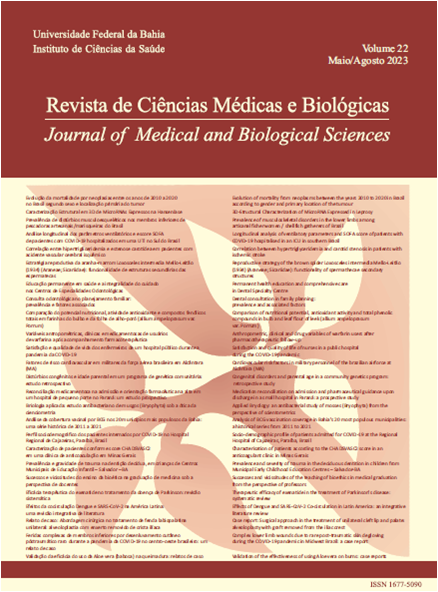Validation of the efficacy of the use of aloe vera (aloe) in the burn: case reports
relatos de caso
DOI:
https://doi.org/10.9771/cmbio.v22i2.53034Keywords:
Aloe vera. Cicatrization. Burns.Abstract
Introduction: the burn causes physical, aesthetic and psychological damage. Aloe vera (aloe) is a medicinal plant with favorable cultivation and therapeutic properties compatible with skin healing. Objective: to evaluate the efficacy of topical use of aloe vera fillet (aloe) in natura, as unconventional cover, in 1st and 2nd degree burns. Objective: evaluate the efficacy of topical use of aloe vera fillet (aloe) in natura, as unconventional cover, in 1st and 2nd degree burns. Methodology: case report with two participants who suffered thermal trauma injuries. Interviews, physical examination, pain assessment and dressing were performed. Aloe vera (aloe vera) harvested from particular cultivation of the researchers, mature leaf, thickness of 4- 6 cm, sanitized, removal of thorns, peel and cutting of the gel in fillets 3 mm, refrigerated 24 hours. There was friction with fillet in the perilesional area, rinse with simple ringer, semicircular movements, one way, primary cover with aloe fillets, secondary cover with moist gauze of distilled water, finished with bandage and micropore. The dehydrated fillet was considered as a saturation point. The participants continued the treatment at home, according to the training performed and orientations. The healing process of the burned lesions until the 20th day was evaluated. Results: there was brief time in reepithelialization with no skin retraction, preservation of pigmentation in areas adjacent to the injured tissue, reduction of pain complaint and risk of infection, low cost in treatment and promotion of autonomy in care. No adverse effects were observed. Conclusion: the use of Aloe vera fillet demonstrated beneficial properties for healing of skin structures, being an alternative in the treatment of thermal traumas, such as burns.
Downloads
Downloads
Published
How to Cite
Issue
Section
License
Copyright (c) 2023 Journal of Medical and Biological Sciences

This work is licensed under a Creative Commons Attribution 4.0 International License.
The Journal of Medical and Biological Sciences reserves all copyrights of published works, including translations, allowing, however, their subsequent reproduction as transcription, with proper citation of source, through the Creative Commons license. The periodical has free and free access.


